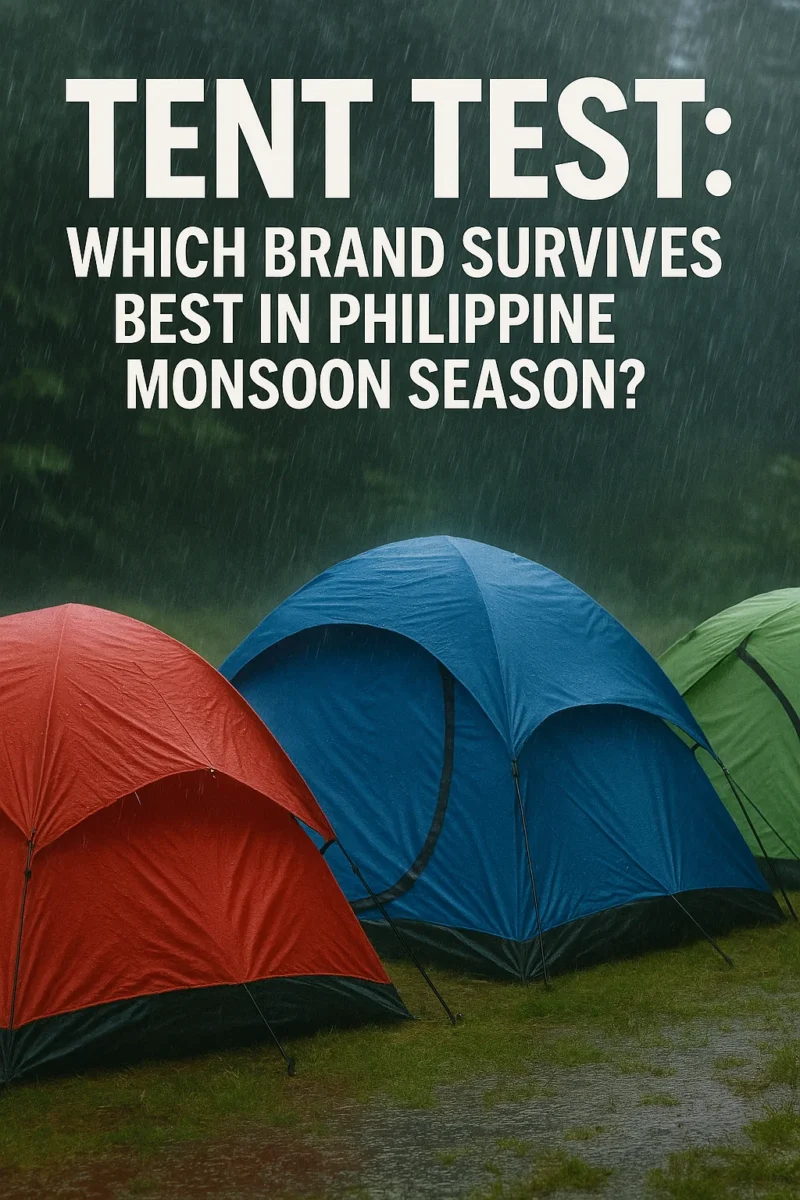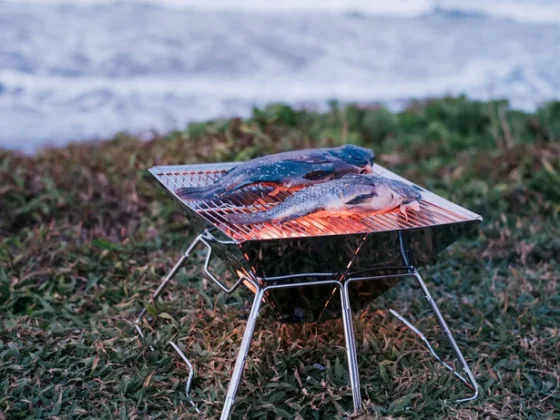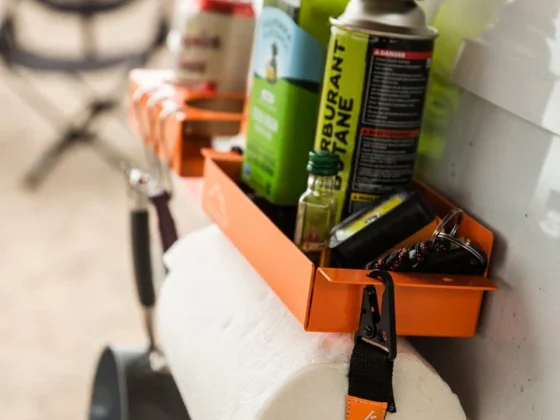When the Philippine monsoon season hits, outdoor adventures take on a new level of challenge. Rains come hard and fast. Winds howl through campsites. And only the most weather-ready campers stick it out. But even the most seasoned outdoorsman is only as good as the gear they bring—and the tent, above all, is the real dealbreaker.
To find out which tent truly performs during the intense rains and gusty winds of a typical monsoon, we tested three tents in real rainy season conditions. Each was chosen for its popularity, practical features, and size options suitable for groups and families. Whether you’re planning a lakeside trip in Laguna, an upland camp in Rizal, or a beach escape during a brief break in the weather, your tent needs to be more than just a shelter. It needs to hold strong, stay dry, and offer comfort when the skies won’t cooperate.
Here’s how the Coleman Instant Tent (6-Person Tent), the Hill Stone ad002 4-Person Camping Tent with Living Room, and the Alps Mountaineering Acropolis 4 performed under pressure.
Monsoon Test Setup
We selected a mid-altitude site in Tanay, Rizal—known for its strong winds and daily rainfall during the peak monsoon months. All three tents were pitched over a one-week period, exposed to real conditions: nightly rains, wet afternoons, and morning mists. The terrain was mixed—some grassy soil, some compact earth—to simulate common Philippine camping surfaces.
We evaluated each tent based on five real-world criteria:
-
Waterproofing
-
Wind resistance
-
Ventilation and condensation control
-
Ease of setup during unexpected rain
-
Comfort and usable space
Coleman Instant Tent (6-Person Tent)
Spacious Shelter with Quick Setup, But Watch the Rainproofing
The name “Instant Tent” doesn’t disappoint. Even in a light drizzle, this six-person tent was set up in just about a minute. Its pre-attached poles and simple unfolding system made it perfect for families or groups who don’t want to fuss with complicated gear.
Interior space is a big win—it’s tall enough to stand inside, with ample room for gear, sleeping bags, and even a small folding table. However, in terms of rain protection, the tent needed some help. It doesn’t come with a full rainfly, which meant heavy rain eventually started to seep through the seams. During our third night of testing, a sustained downpour left small pools of water forming along the edges.
We recommend using a separate tarp or waterproof cover to reinforce this tent during peak monsoon weeks. On drier nights or during short bursts of rain, it held up fairly well and remained one of the most comfortable options for space and airflow.
The larger size and near-vertical walls also allowed us to add a lightweight awning tent extension at the front for gear drying and an outdoor cooking area. This helped keep the sleeping zone clean and dry.
Hill Stone ad002 4-Person Camping Tent with Living Room
Smart Layout with All-Weather Potential
This tent surprised us with one of the most efficient space layouts in the group. Designed for four people, it includes a main sleeping area plus a front “living room” space, ideal for storing gear, lounging, or even waiting out the rain. The living room concept worked brilliantly—especially during an afternoon thunderstorm when our team stayed dry while playing cards inside.
Weather resistance was respectable. With a full-coverage rainfly, taped seams, and a bathtub-style floor, the tent kept water out even after six hours of non-stop rain. Its low-profile shape gave it good stability during windy conditions. We reinforced it with guy lines, and it remained solid through 35 km/h gusts.
Setup was relatively straightforward, though it took a little longer than the others. Having two people helps, especially to position the rainfly securely over the extended front room.
Another win was its airflow. The side windows and mesh panels gave enough ventilation without compromising dryness. Moisture buildup was minimal, even during muggy nights when everything outside felt damp.
Its extended living space functioned as an awning tent substitute. While not an awning in design, it provided similar protection and convenience, which made it a favorite during mid-storm cooking and quick gear changes.
Alps Mountaineering Acropolis 4
Built Tough, Handles the Worst Weather Well
This tent proved to be the most storm-ready in our lineup. Built for alpine conditions, the Alps Mountaineering Acropolis 4 combines rugged materials with a stable structure that can take a beating. While it’s slightly heavier and bulkier when packed, it earns its place in any monsoon-season gear list.
Waterproofing was excellent. A full-coverage fly, factory-sealed seams, and tough floor fabric kept the interior completely dry through multiple rain events, including one that lasted nearly 10 hours overnight. No leaks, no puddles, and no soaking through.
Its pole system features sturdy aluminum instead of fiberglass, which significantly boosted its wind resistance. We saw no bending or bowing, even during a stormy night with strong gusts rattling nearby trees.
Ventilation was also thoughtfully designed. With dual doors, large vestibules, and multiple mesh panels, the tent remained fresh and breathable throughout the test period. Even with all four occupants inside, there was no condensation buildup.
Although it doesn’t have a built-in awning tent feature, the vestibule space was generous enough to serve as gear storage and a buffer zone. We used the area to remove wet shoes, set down muddy bags, and hang damp clothes—all without bringing any moisture into the sleeping quarters.
Setup took more time compared to the other two tents, but the structure and confidence it gave during severe weather made it well worth the effort.
Final Verdict: Which Tent Stands Tall in a Philippine Downpour?
The verdict depends on your camping style—but one thing’s clear: all three tents have their place in monsoon-season camping if used correctly.
| Criteria | Best Performer |
|---|---|
| Setup Speed | Coleman Instant Tent |
| Rain Protection | Alps Mountaineering Acropolis 4 |
| Wind Resistance | Alps Mountaineering Acropolis 4 |
| Comfort/Layout | Hill Stone ad002 4-Person Tent |
| Value for Family Camping | Hill Stone ad002 4-Person Tent |
Coleman’s Instant Tent is best for those who want a quick shelter with lots of space—just be ready to upgrade its rain protection during strong storms.
Hill Stone’s ad002 brings together livability and solid waterproofing, making it an ideal middle ground for groups who want comfort and durability.
Alps Mountaineering’s Acropolis 4 is the one to beat for serious campers who want a fortress against wild weather, especially if you’re venturing out during the height of the rainy season.
Final Tips for Monsoon-Season Campers
-
Always bring an extra ground tarp. It adds insulation and protects the tent floor.
-
Angle your tent away from natural water flow paths. Don’t pitch in a low area.
-
Use waterproofing spray on seams and zippers before the trip.
-
Pack a microfiber towel to dry off condensation inside the tent, just in case.
A little preparation goes a long way when the skies open up. With one of these three tents properly set up and maintained, there’s no reason rain has to ruin your weekend in nature. In fact, there’s something peaceful and grounding about falling asleep to the sound of rainfall—safe, dry, and comfortable inside a tent that’s proven its worth.



